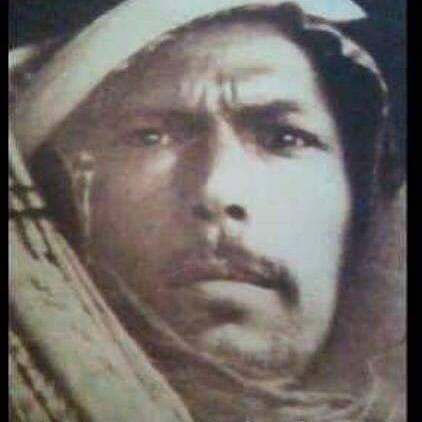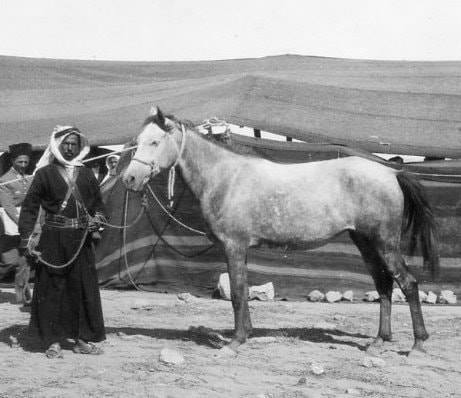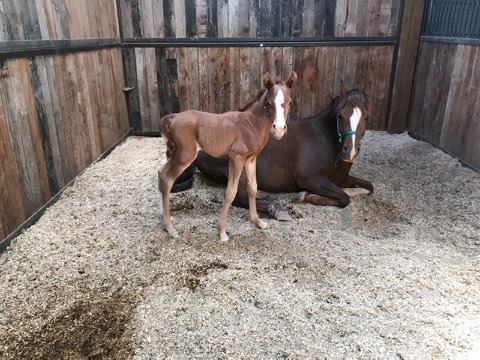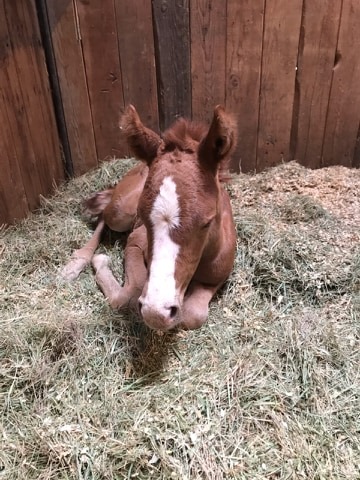Introducing Shaykh Al Arab
That will be the pompous official name of my new Ma’naqi colt. He is so named in memory of the foundation sire of Lebanese Arabians. The original Shaykh Al Arab (1940s) was an ‘Ubayyan Sharrak but he was sired by a Ma’naqi Sbayli. His owner Henri Pharaon named him after his breeder, Rakan Ibn Mirshid, the Shaykh of the Gmassah Bedouins and of the larger Sba’ah Bteynat tribe (b. 1892 in the desert — d. 1982 in Kuwait).
Rakan (photo below, I think by Carl Raswan, and another photo holding his mare) was the son of Bashir, the son of Sulayman Ibn Mirshid, the leader of Sba’ah from whom Captain Upton bought Haidee in 1874. The new colt traces to Haidee in the maternal line.


Rakan was a progressive and open Bedouin leader, who called for peace between the tribes and for them to abondon their nomadic lifestyle. Rakan was preceded in the leadership of the Sba’ah by his father Bashir, his uncle Ghatwan, his other uncle Hazza’, his father’s paternal cousin Butayyin (the Beteyen of Lady Anne), his father’s other paternal cousin Mashhur, and his grandfather Sulayman. Sulayman had led a rebellion of his tribe against the Ottomans. He died in 1876 after the Ottoman governor of Deir El Zor put poison in his coffee cup. I suspect the prospect of an alliance with the British must have led Sulayman to sell some of his tribe’s best mares to Captain Upton (of the 9th Lancers), including Haidee and Kesia.
Today the Sheykh of the Sba’ah is Mutshir son of Trad son of Rakan. He lives in Riyadh, Saudi Arabia. An overview of the history of the prestigious Bedouin family of Ibn Mirshid is way overdue on this blog. Meanwhile, I am sharing these pictures of Shaykh. They were sent by DeWayne, who just calls him…. well, “Eddy”.


No lie, the opening line made me belly-laugh. Thanks for that!
I love when names have history attached to them. The foal is precious, and I hope he lives up to his name and the dreams held for him.
Congratulations Edouard! Lovely boy and a good name.
A good name indeed, though Eddy may well stick as his barn name!
that just underscores how differently east and west think about horse names.
Oh? What’s the difference, if you don’t mind me asking?
We don’t do barn names. We like names that project a sense of pride and glory, not “Spike” or “Eddy”.
We never did, either. It’s hard enough to remember all the formal names! Charles’s father did nickname Aramis “Sam,” because he always wanted to call a horse Sam. But Charles and I called him Aramis, and that was that!
Oh, that’s interesting! Barn names were an entirely new thing to me when my family moved to the US – before then, the horses I had known had always gone by their actual names, or a shortened version of them, e.g. Jamaican Doll was usually called Jamaica, or, if you were feeling particularly affectionate, Jammy, Floral Fantasy was often called Fanta. Having a completely different registered name from the name used every day was definitely odd. Though the horses I knew growing up did not always have exactly glorious names – there were multiple Patches, for example!